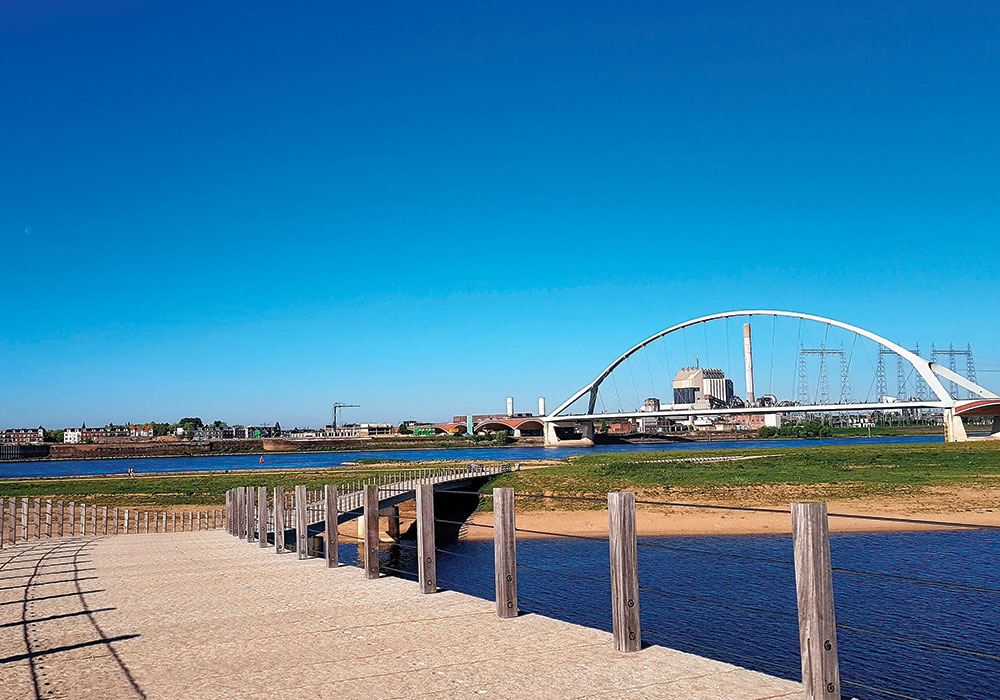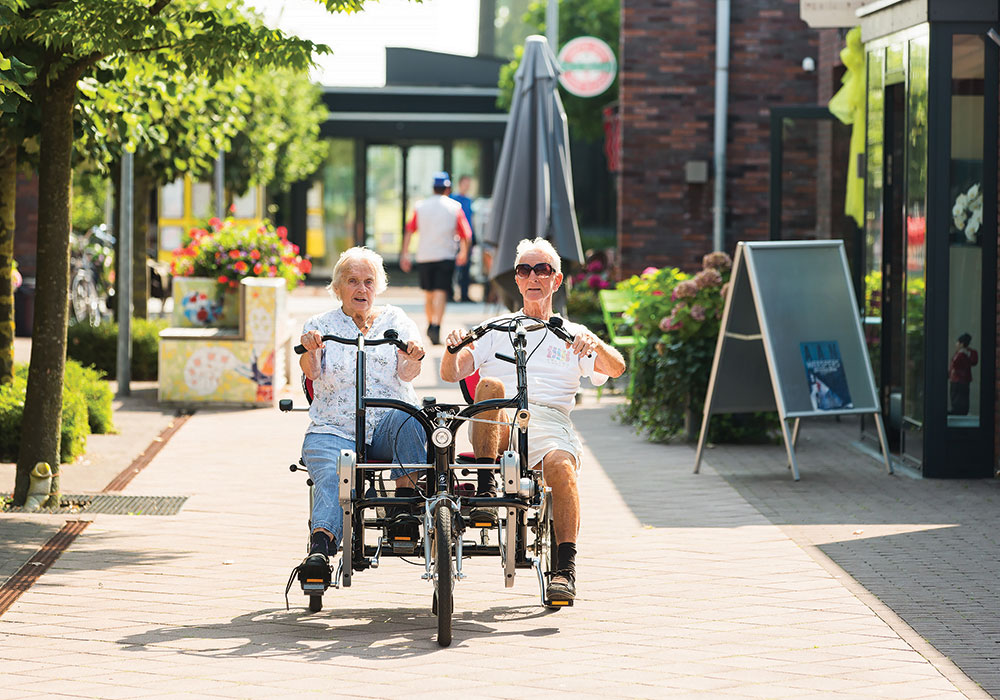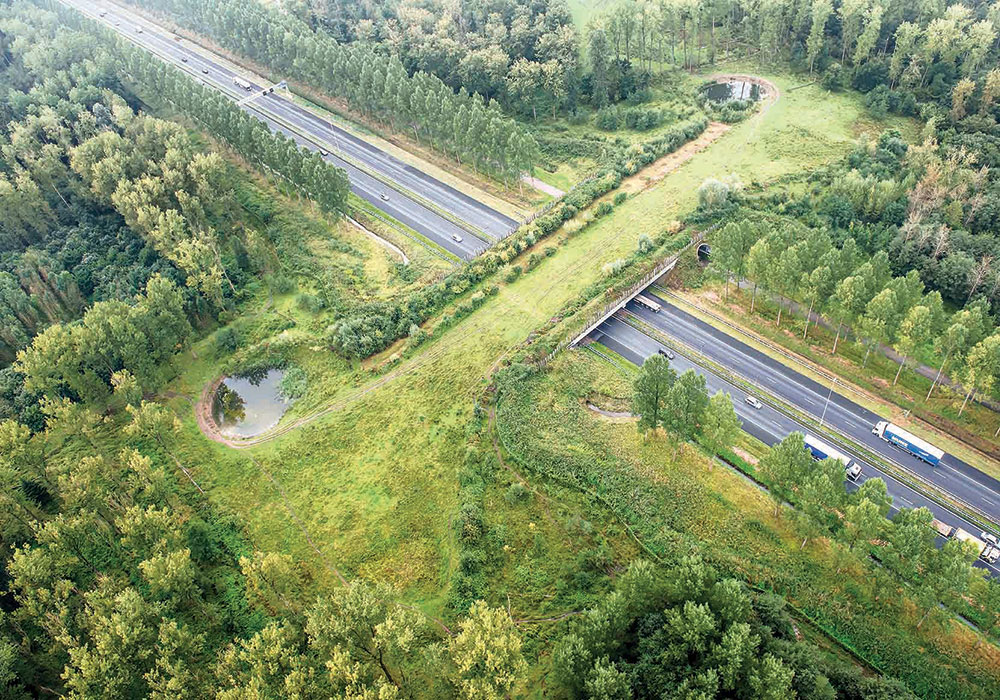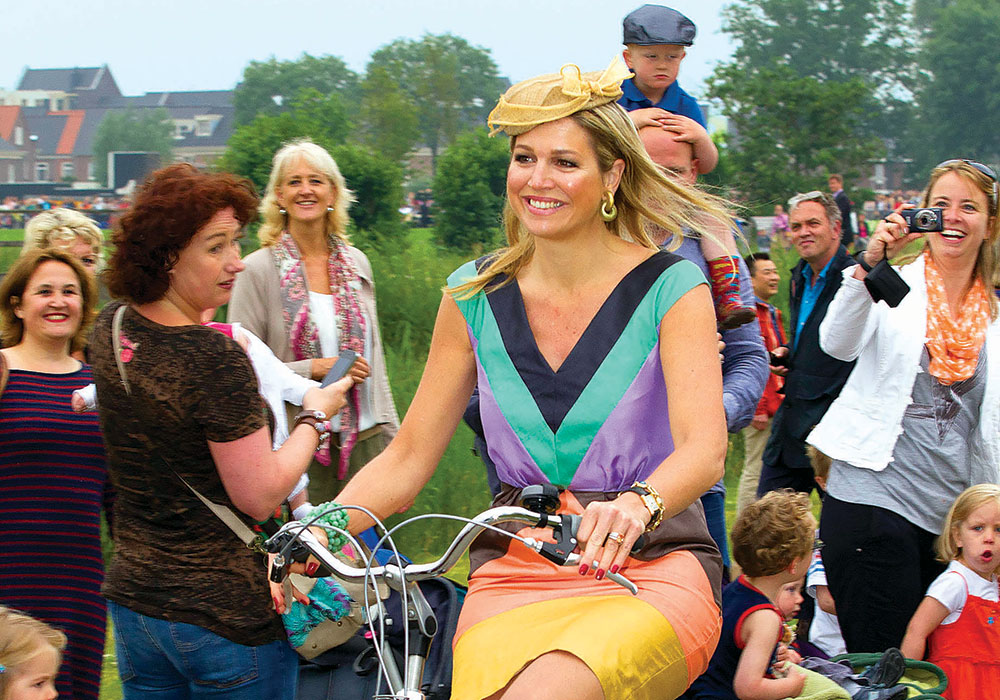Planning July 2019
7 Great Ideas to Steal from the Dutch
From flood prevention to wildlife crossings, the Netherlands is a small country with a knack for solving big problems.
By Elaine Robbins
Whenever we read about the latest nifty innovation coming out of the Netherlands, my husband, a Dutch research scientist, likes to joke that it's "yet more evidence of the inherent superiority of the Dutch." I roll my eyes, but I have to admit: Like all good jokes, this one contains an element of truth. The Dutch seem more practical and forward-thinking than other countries about so many things, from water and transportation planning to parent-friendly policies. Here are a few of my favorite ideas worth stealing.
Dutch practical, forward-thinking ideas worth emulating
1. Spend big on water planning, not disaster recovery.

Room for the River projects restore floodplains while providing recreational amenities for the cities they protect. Here, bridges over the river Waal in Nijmegen, which got a new island and beach in the process. Photo by Jasper Ragetlie, iStock/Getty Images Plus.
Severe hurricanes cost the U.S. $300 billion in 2017 alone, and that price tag is only expected to rise. Unless we can slow climate change, coastal and inland communities alike will face more frequent and severe flooding. But every $1 spent on protection saves $6 in disaster costs, according to a recent study by the National Institute of Building Sciences.
That's a lesson the Dutch have incorporated into their DNA. With a third of the country below sea level, they realized long ago that they couldn't rely just on dikes to hold back the sea anymore. (Hans Brinker wouldn't be much use on his silver skates, anyway. A warming climate has halted the country's long-distance skating event, which requires thick ice, since 1997.)
Instead, their new approach is evident in some 30 "Room for the River" projects nearing completion around the country. The projects are designed to restore floodplains, dig new secondary channels — my husband's hometown of Nijmegen even got a new island and beach in the process.
The Dutch plan for 10,000-year floods — compared with our woefully inadequate 100-year flood standard — and as a result, they haven't had a death from flooding in 65 years. It's no wonder that Dutch water planners are in high demand, sharing their expertise from Boston to Bangladesh.
2. Grow more with less.

Photo by Pidjoe.
How do you become the world's number two agricultural exporter after the U.S. when your country is just one-sixteenth the size of Texas? By making sustainable farming a national government goal, not just the fringe pursuit of idealistic young farmers. Some 20 years ago the Netherlands set out to increase yields and reduce inputs. Now it grows not just the world's tulips but a major share of its tomatoes, peppers, onions, and potatoes, in vast greenhouses in the Westland region. And they do it without sun (using LED lights) or pesticides, with up to 90 percent less water use.
Dutch tomatoes may not taste like home-grown, but as a soaring world population tries to feed itself while facing challenges such as limited resources, degraded farmland, and climate change, Dutch methods could do nothing less than avert mass famine. That's something the Netherlands experienced during the Hunger Winter of 1944–45, and why "ag tech" Wageningen University recruits a bumper crop of grad students from developing countries. Dutch farmers don't sit around jawing about the weather: They're too busy tromping around the world to share and learn.
3. Build more protected bike lanes.

Photo by iStock/Getty Images: Nisangha.
It's not exactly news that the Netherlands is the biking capital of the world. Or that new bike paths and 60,000-stall bike parking lots are popping up faster than tulips in springtime. In fact, Amsterdam's bike lobby is so powerful that during the Rijksmuseum's recent $500 million renovation, it forced architects to retain the popular bike path that cuts right through the building (above).
Perhaps one feature of the country's bike-friendly infrastructure most worth stealing is the notion of protected bike lanes on streets where auto traffic moves faster than 20 miles per hour. Fortunately, U.S. cities have caught on in recent years. New York City leads the way with 124 miles of protected lanes. In a city where "bike messenger" used to be one of the most dangerous job titles, a whopping 50 percent more people ride several times a month than a decade ago.
4. Raise happy children.

Photo by Anna Nahbed.
The Dutch raise the world's happiest children, according to a UNICEF ranking. Even more impressive, they boast the happiest teenagers on the planet.
An enviable 29-hour average work week certainly helps, so parents can spend more time with their children. Kids also face less academic pressure: Their school progress, which leads to one of three tracks, is guided by their own interests and talents.
Of course, these factors are largely cultural, but a child-friendly built environment also plays a role. Low city speed limits, bike lane barriers, and other traffic-calming methods make Dutch streets safer for children. Think it can't happen here? It helps to remember that it wasn't always that way there, either. The bike-friendly planning that we think of as inherently Dutch is actually a result of a 1970s campaign by Dutch parents to take back their streets after a postwar rise in car traffic and child deaths. We may never achieve the Dutch rate of 75 percent of children who bike to school, but on the route to raising happier children, every little bit helps.
5. Design compassionate memory-care communities.

Photo courtesy de Hogeweyk.
Last summer the first "dementia village" opened in the U.S. in a suburb of San Diego. Called Town Square, the old-timey '50s-era Main Street is one of many such communities on the drawing board around the world.
Their inspiration is de Hogeweyk, a Dutch village for people with advanced dementia that opened in 2009. De Hogeweyk (above) radically replaced meds and lockdowns with familiarity and freedom — approaches that are known to calm and improve the well-being of people with Alzheimer's. Built to resemble a Dutch village, it houses residents in 27 houses with people of similar backgrounds to create a familial feeling. Residents can wander along outside paths or go to the pub or shopping mall. A gate around the perimeter keeps residents from going out, but townspeople are encouraged to come in to enjoy the restaurant and courtyard.
San Diego's new Town Square is just for day visits, not residential care like de Hogeweyk, but it offers a much-needed new approach to compassionate care for the 5.7 million Americans living with Alzheimer's — a number predicted to rise to 14 million by 2050.
6. Install highway wildlife crossings.

Photo by Joop van Houdt/Rijkswaterstaat.
The Netherlands wasn't the first country to build overpasses or underpasses to help wildlife cross roads safely. France built such structures in the 1950s. But it does boast the world's longest overpass: the 2,600-foot-long Natuurbrug Zanderij Crailoo, a land bridge that helps critters safely traverse a landscape of highways, railroads, a sports stadium, and a golf course. Today more than 1,500 crossings protect everything from red deer to butterflies.
But what truly makes the Netherlands a world model is that wildlife connectivity is considered as part of nearly every road building plan. Transportation planners and conservationists worked at the national, provincial, and local levels to recently complete 85 percent of the ambitious MJPO (Multi-Year Defragmentation Program). Now nearly 600 connectivity bottlenecks have been fixed — and animals can more safely cross the road (like the A2 highway near Eindhoven, above) in one of the most densely populated countries in Europe.
7. Go forth with confidence.

Photo by Nieboer/PPE/SIPA USA.
The Dutch are never showy or boastful; even the royals (Queen Maxima, above) ride bikes just like everyone else. But they don't believe in false modesty, either, as my husband's attitude makes clear. They have confidence in their own talents, as in, "I speak excellent English, German, and Tagalog." With the time they save not having to prop up their self-esteem, they master another language, play an instrument, or raise happy children.
So go forth with confidence, and don't be afraid to toot your own horn. Who knows? Bolstered by your newfound confidence, you may find the next great idea worth stealing.
Elaine Robbins is a freelance writer and editor in Austin, Texas.


